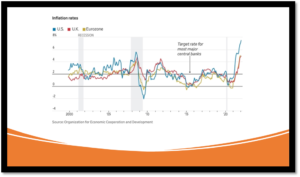
The logic for prolonged inflation was explained by Charles Goodhart, former UK Central Banker: “He argued that the low inflation since the 1990s wasn’t so much the result of astute central-bank policies, but rather the addition of hundreds of millions of inexpensive Chinese and Eastern European workers to the globalized economy, a demographic dividend that pushed down wages and the prices of products they exported to rich countries. Together with new female workers and the large baby-boomer generation, the labor force supplying advanced economies more than doubled between 1991 and 2018. Now, he said, the working-age population has started shrinking across advanced economies for the first time since World War II, and birthrates have declined as well. China’s working-age population is expected to shrink by almost one-fifth over the next 30 years. As labor becomes scarcer, he maintained, workers will push for higher wages, in turn driving up prices. At the same time, businesses will manufacture and invest more locally to help offset both labor shortages and the nationalist and geopolitical pressures curbing globalized supply chains. That will increase production costs and local workers’ bargaining power. Global savings will fall as older people consume more than they produce, spending particularly on healthcare. All that will push up interest rates, he predicted.” [Thanks to Tom Fairless at WSJ for quote]
So, what is the message for today’s retailers? Most of the merchants and buyers who are negotiating pricing and setting retails were not in business back in the 1970’s when inflation was raging, and interest rates hit 17%. It has not been difficult to control pricing and demand concessions from their vendors. Now new skills must be learned to avoid or delay price increases.
Retail pricing will become more dynamic. While customers will become more price conscience, landed costs of products to stores and warehouses plus logistic costs to homes and jobsites will skyrocket. This will impact all retailers but especially affect e-commerce where customers have come to expect a high degree of service without being charged a premium for it. This paradigm will have to change.
